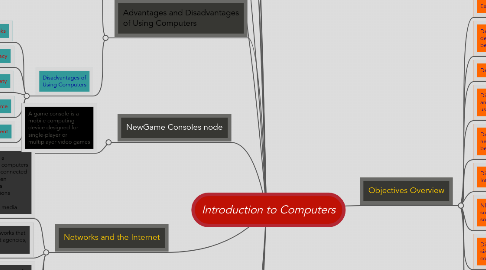Introduction to Computers
by ณัฐกรณ์ คำชัยวงค์

1. A World of Computers
1.1. Computers are everywhere
2. What Is a Computer?
2.1. A computer is an electronic device, operating under the control of instructions stored in its ownmemory
2.1.1. Collects data (input)
2.1.2. Processing
2.1.3. Produces information (output)
3. The Components of a Computer
3.1. A computer contains many electric, electronic, and mechanical components known as hardware
3.1.1. Input Device
3.1.1.1. Allows you to enter data and instructions into a computer
3.1.2. System Unit
3.1.2.1. that contains the electronic components of the computer that are used to process data Case
3.1.3. Storage Device
3.1.3.1. Holds data, instructions, and information for future use
3.1.4. Communications Device
3.1.4.1. Enables a computer to send and receive data, instructions, and information to and from one or more computers or mobile devices
4. Advantages and Disadvantages of Using Computers
4.1. Advantages of Using Computers
4.1.1. Speed
4.1.2. Reliability
4.1.3. Consistency
4.1.4. Storage
4.1.5. Communications
4.2. Disadvantages of Using Computers
4.2.1. Health Risks
4.2.2. Violation of Privacy
4.2.3. Public Safety
4.2.4. Impact on Labor Force
4.2.5. Impact on Environment
5. Advantages and Disadvantages of Using Computers
5.1. Green computing involves reducing the electricity consumed and environmental waste generated when using a computer
5.2. Strategies include
5.2.1. Recycling
5.2.2. Regulating manufacturing processes
5.2.3. Extending the life of computers
5.2.4. Immediately donating or properly disposing of replaced computers
6. Networks and the Internet
6.1. A network is a collection of computers and devices connected together, often wirelessly, via communications devices and transmission media
6.2. The Internet is a worldwide collection of networks that connects millions of businesses, government agencies, educational institutions, and individuals
6.3. New People use the Internet for a variety of reasonsnode
6.4. A social networking Web site encourages members to share their interests, ideas, stories, photos, music, and videos with other registered users
7. Computer Software
7.1. Software, also called a program, tells the computer what tasks to perform and how to perform them
7.2. Installing is the process of setting up software to work with the computer, printer, and other hardware
7.3. A programmer develops software or writes the instructions that direct the computer to process data into information
8. NPersonal Computersew node
8.1. A personal computer can perform all of its input, processing, output, and storage activities by itself
8.2. Two popular architectures are the PC and the Apple
9. NewGame Consoles node
9.1. A game console is a mobile computing device designed for single‐player or multiplayer video games
10. Servers
10.1. NeA server controls access to the hardware, software, and other resources on a network – Provides a centralized storage area for programs, data, and informationw node
11. Mainframes
11.1. A mainframe is a large, expensive, powerful computer that can handle hundreds or thousands of connected users simultaneously
12. New noSupercomputersde
12.1. A supercomputer is the fastest, most powerful computer – Fastest supercomputers are capable of processing more than one quadrillion instructions in a single second
13. Objectives Overview
13.1. Explain why computerliteracy is vital tosuccess in today’s world
13.2. Define the term,computer, and describe the relationship between data andinformation
13.3. Describe the five components of a computer
13.4. Discuss the advantages and disadvantages that users experience when working withcomputers
13.5. Define the term, network, and identify benefits of sharing resources on a network
13.6. Discuss the uses of the Internet and World WideWeb
13.7. NDistinguish between system software and application softwareew node
13.8. Differentiate among types, sizes, and functions of computers in each category
13.9. NewDescribe the role of each element in an information system node
13.10. Explain how home users,small office/home office users, mobile users, power users, and enterprise userseach interact with computers
13.11. Discuss how society uses computers in education, finance, government, health care science,publishing, travel, and manufacturing

